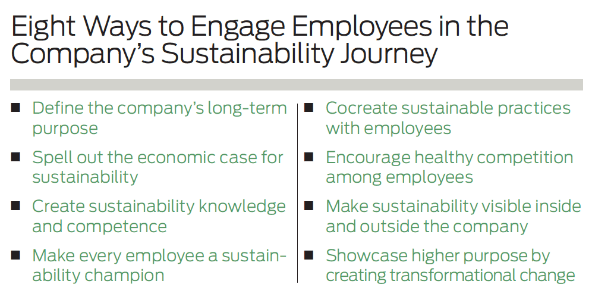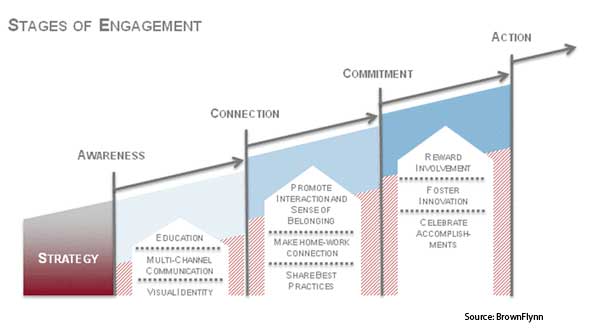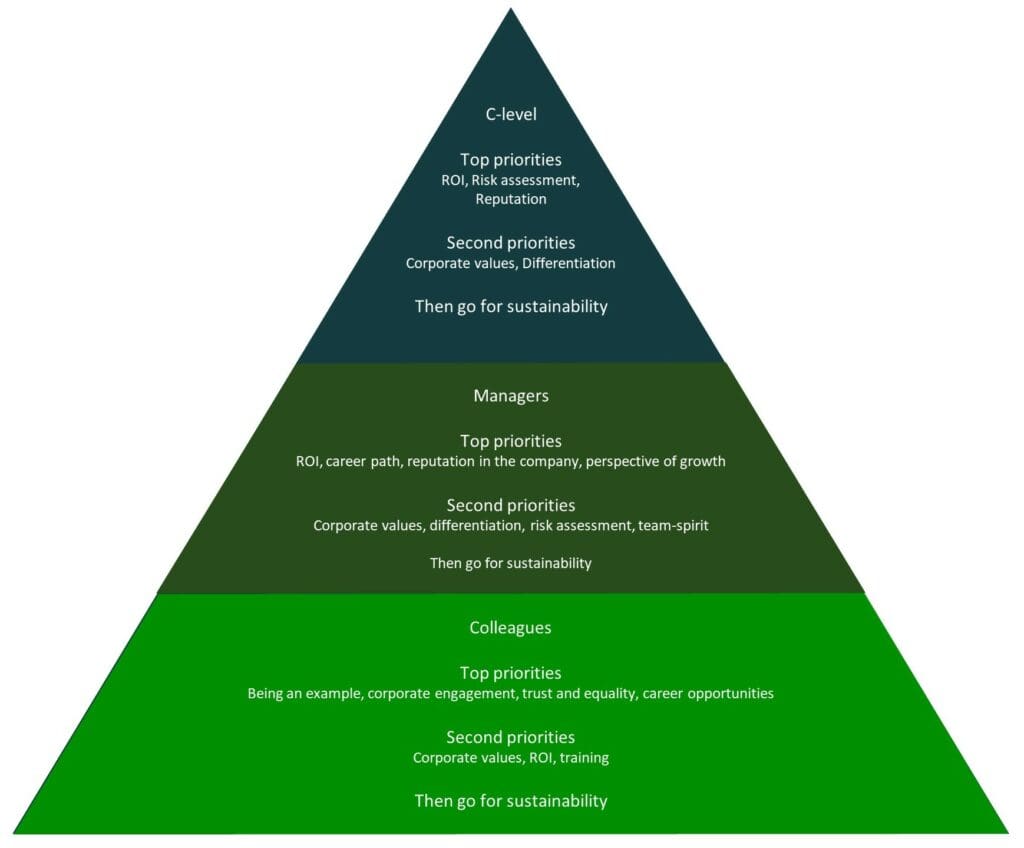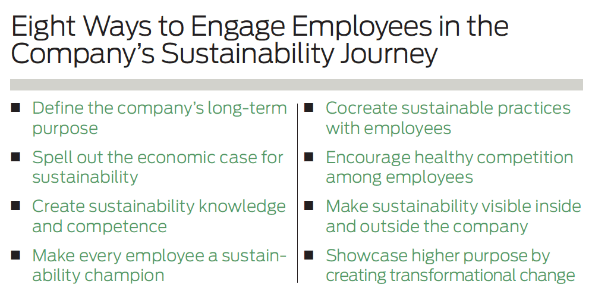Are you interested in fostering a culture of sustainability within your company? Look no further! In “Partnering For The Planet: How To Engage Employees In Your Company’s Sustainability Journey,” we explore the importance of corporate sustainability and share valuable insights on how to effectively involve your employees in this crucial undertaking. By creating a united front and working together towards common environmental goals, your company can make a significant impact on the planet while simultaneously fostering employee engagement and pride. Let’s dive into the strategies that will empower your workforce to become sustainability champions!


The Importance of Engaging Employees in Sustainability
As businesses increasingly recognize the importance of sustainability, engaging employees in this journey has become crucial. When employees are actively involved in sustainability initiatives, it creates a culture of sustainability within the organization, driving innovation and efficiency while also improving corporate reputation. Furthermore, engaging employees in sustainability efforts increases their satisfaction and helps with employee retention.
Creating a Culture of Sustainability
To foster a culture of sustainability, it is essential to ensure that employees at all levels understand their role in this journey. By creating awareness and fostering a sense of ownership, employees become more motivated to contribute to sustainable practices.
One way to cultivate this culture is by integrating sustainability into the organization’s core values and mission statement. By aligning sustainability goals with the overall purpose of the company, employees can understand the broader impact of their actions.
Driving Innovation and Efficiency
Engaging employees in sustainability can lead to innovative solutions and increased efficiency. When employees are encouraged to think creatively about sustainability challenges, it sparks innovation and can result in new practices or initiatives that positively impact the organization and the environment.
Employees often possess unique insights and perspectives that can drive innovation in sustainability efforts. By involving them in decision-making processes and seeking their input, organizations can tap into this valuable resource and identify opportunities for improvement.
Improving Corporate Reputation
Engaging employees in sustainability can significantly enhance a company’s reputation. When employees actively participate in sustainability initiatives, they become ambassadors for the organization’s commitment to environmental and social responsibility.
Externally, customers and stakeholders view an organization more favorably when they see employees genuinely invested in sustainability goals. This positive perception can increase brand loyalty and attract new customers who share similar values.
Increasing Employee Satisfaction and Retention
Engaging employees in sustainability efforts has a positive impact on their satisfaction and overall job experience. Employees often feel a sense of pride and fulfillment when they are part of a company that prioritizes sustainability. This engagement can lead to increased employee loyalty, productivity, and even help with talent attraction and retention.
When employees are given opportunities to contribute to sustainability initiatives, they feel empowered and recognized for their efforts. This engagement creates a positive work environment and fosters a sense of purpose, ultimately leading to higher levels of job satisfaction and employee retention.
Identifying Key Stakeholders
Before developing a comprehensive employee engagement strategy for sustainability, it is crucial to identify and understand the key stakeholders within the organization. These stakeholders can be both internal and external, each playing a vital role in driving sustainability efforts.
Identifying Internal Stakeholders
Internal stakeholders include employees at all levels, from executives and management to non-office employees. Each group of stakeholders contributes unique perspectives and experiences that can significantly impact sustainability initiatives.
By identifying and involving internal stakeholders, organizations can tap into the diverse skill sets and ideas that employees possess. These individuals often have valuable insights on the practical aspects of sustainability and can provide essential input during the planning and implementation phases.
Engaging Executives and Management
Executives and management play a crucial role in driving sustainability initiatives within an organization. Their support and commitment are essential for effectively integrating sustainability into the company’s strategic goals.
To engage executives and management, it is important to communicate the business case for sustainability and emphasize the potential benefits. By aligning sustainability efforts with the organization’s overall objectives, leaders can see the value in investing time and resources into these initiatives.
Including Non-Office Employees
In many organizations, non-office employees may be overlooked when it comes to engagement in sustainability efforts. However, they often make up a significant portion of the workforce, and their active participation is critical for holistic sustainability practices.
To include non-office employees, organizations can provide opportunities for them to contribute ideas and suggestions. In addition, effective communication and training programs should be tailored to meet the specific needs and preferences of non-office employees, ensuring their inclusion in sustainability efforts.
Considering External Stakeholders
While internal stakeholders are important drivers of sustainability, external stakeholders also play a significant role in an organization’s sustainability journey. These stakeholders may include customers, suppliers, community members, and regulatory bodies, among others.
By considering external stakeholders and their perspectives, organizations can gain a broader understanding of the sustainability challenges they face. Engaging these stakeholders in sustainability initiatives can lead to mutually beneficial partnerships and alliances that drive further progress towards sustainability goals.
Building Awareness and Understanding
Creating awareness and understanding of sustainability goals and initiatives among employees is essential for successful engagement. By educating employees, communicating goals clearly, highlighting the benefits, and addressing any concerns or questions, organizations can ensure that employees are well-informed and motivated to participate.
Educating Employees on Sustainability
To engage employees, organizations must provide education and training programs that deliver a comprehensive understanding of sustainability. This includes raising awareness about the environmental, social, and economic impacts of unsustainable practices and the benefits of adopting sustainable alternatives.
By equipping employees with the knowledge and skills necessary to make informed decisions and take sustainable actions, organizations can foster a sense of ownership and empowerment in their sustainability efforts.
Communicating Sustainability Goals and Initiatives
Clear and consistent communication is vital to engage employees in sustainability initiatives. Organizations should communicate their sustainability goals, strategies, and progress regularly through various channels, such as company-wide meetings, newsletters, emails, and intranet platforms.
By transparently sharing information about sustainability efforts, organizations demonstrate their commitment to employee engagement and foster a sense of shared purpose. This communication also allows employees to understand how their individual actions contribute to the overall sustainability goals of the organization.
Highlighting the Benefits of Sustainability
One effective way to engage employees in sustainability is by highlighting the personal and organizational benefits. Communicating the positive impact of sustainable practices on employees’ health and well-being, as well as the potential cost savings or competitive advantages for the organization, can inspire greater participation.
By demonstrating the direct relationship between sustainability and the success of the organization, employees are more likely to embrace sustainable behaviors and actively contribute to sustainability initiatives.
Addressing Employee Concerns and Questions
Engaging employees in sustainability requires addressing their concerns and questions. Organizations should create platforms for open dialogue, allowing employees to voice their opinions, express their concerns, and seek clarification on sustainability goals and initiatives.
By actively listening to employee feedback and addressing their concerns, organizations can build trust and create an environment where employees feel heard and valued. This open communication also fosters a sense of collaboration, allowing organizations to refine their sustainability strategies based on the input received.
Setting Clear Sustainability Goals
To engage employees effectively, organizations must set clear and measurable sustainability goals. By defining targets, aligning goals with company values, including employee input, and developing timelines, organizations can provide a roadmap for employee engagement in sustainability.
Defining Measurable Targets
Sustainability goals should be specific, measurable, attainable, relevant, and time-bound (SMART). By clearly defining the targets, organizations provide employees with a sense of purpose and direction in their sustainability efforts.
Whether it is reducing carbon emissions, increasing recycling rates, or improving energy efficiency, setting measurable targets allows organizations to track progress and celebrate achievements along the way.
Aligning Goals with Company Values
To engage employees authentically, sustainability goals must align with the organization’s core values. When employees understand how sustainability is connected to the company’s overall mission and values, they are more likely to embrace and actively participate in sustainability initiatives.
By integrating sustainability into the organization’s values and culture, organizations can create a workplace where sustainable practices are deeply ingrained and embraced by all employees.
Including Employee Input in Goal-Setting
Employees are valuable stakeholders when it comes to setting sustainability goals. By involving employees in the goal-setting process, organizations can tap into their expertise and perspectives, ensuring that goals are realistic and relevant.
Engagement can be fostered through surveys, focus groups, or workshops, where employees have the opportunity to provide input and suggest sustainability goals that resonate with their own values and priorities. This inclusion creates a sense of ownership and increases employee commitment to achieving the identified goals.
Developing Timelines and Milestones
Setting clear timelines and milestones is essential for achieving sustainability goals. By breaking down the larger goals into smaller, actionable steps, organizations provide employees with a sense of progress and direction.
Timelines and milestones also allow organizations to monitor progress and identify any areas that may require additional support or resources. Celebrating achievements along the way helps maintain employee motivation and reinforces the value of their contributions to sustainability efforts.


Providing Training and Resources
To engage employees effectively in sustainability initiatives, organizations must provide the necessary training and resources. By offering sustainability training programs, creating employee resource networks, providing access to sustainability tools and technologies, and establishing sustainability libraries or knowledge bases, organizations can enable employees to drive change.
Offering Sustainability Training Programs
Sustainability training programs are essential for equipping employees with the knowledge and skills needed to implement sustainable practices effectively. These programs can cover a range of topics, such as waste management, energy conservation, sustainable procurement, and sustainable design.
By providing comprehensive training, organizations ensure that employees have a clear understanding of sustainability concepts and are aware of the practical steps they can take to contribute to sustainability goals.
Developing Employee Resource Networks
Employee resource networks or affinity groups focused on sustainability can be valuable resources for engaging employees. These networks create opportunities for employees to connect, share best practices, and collaborate on sustainability initiatives.
By fostering a sense of community and belonging, these networks help employees feel supported and motivated, ultimately driving a more significant impact on sustainability efforts.
Providing Access to Sustainability Tools and Technologies
Organizations can empower employees by providing access to sustainability tools and technologies. This may include energy management systems, waste tracking software, or sustainability assessment tools.
By furnishing employees with the necessary resources, organizations enable them to monitor and measure their sustainability efforts effectively. Access to these tools also facilitates collaboration and knowledge sharing among employees, further enhancing the impact of sustainability initiatives.
Creating a Sustainability Library or Knowledge Base
A sustainability library or knowledge base serves as a centralized repository of information, resources, and best practices related to sustainability. This resource can be accessible to all employees, providing a platform for continuous learning and inspiration.
By curating a wide range of sustainability resources and case studies, organizations foster a culture of knowledge sharing, enabling employees to stay informed, learn from others’ experiences, and explore new ideas for sustainability initiatives.
Empowering Employee Action
Empowering employees to take action is crucial for meaningful engagement in sustainability initiatives. By encouraging employee-led sustainability projects, supporting sustainability committees or task forces, recognizing and rewarding contributions, and promoting collaboration and cross-departmental initiatives, organizations can harness the power of their workforce.
Encouraging Employee-Led Sustainability Projects
Encouraging employees to propose and lead sustainability projects is an effective way to engage them in sustainability. By empowering employees to take ownership of their ideas and initiatives, organizations tap into their creativity and passion for making a difference.
Supporting employee-led projects not only increases employee engagement but also fosters a culture of innovation and continuous improvement.
Supporting Sustainability Committees or Task Forces
Establishing sustainability committees or task forces can be an effective way to engage employees and leverage their skills and expertise. These groups provide a platform for employees from different departments or areas of expertise to collaborate on sustainability initiatives.
By involving employees at all levels in these committees or task forces, organizations create a sense of shared responsibility and promote cross-departmental collaboration, resulting in more comprehensive and impactful sustainability efforts.
Recognizing and Rewarding Employee Contributions
Recognizing and rewarding employee contributions to sustainability efforts is essential for sustaining engagement and motivation. Organizations can establish recognition programs or incorporate sustainability metrics into existing employee reward and recognition systems.
By acknowledging and celebrating individual and team contributions, organizations reinforce the value of sustainable behavior and inspire others to participate actively in sustainability initiatives.
Promoting Collaboration and Cross-Departmental Initiatives
Collaboration and cross-departmental initiatives are essential for maximizing the impact of sustainability efforts. By breaking down silos and promoting collaboration, organizations enable employees to work together towards shared sustainability goals.
Creating opportunities for employees from different departments or teams to collaborate on sustainability projects encourages diverse perspectives and fresh ideas. This cross-collaboration can lead to innovative solutions and a more integrated approach to sustainability within the organization.


Tracking and Celebrating Progress
Tracking progress and celebrating achievements are critical aspects of engaging employees in sustainability initiatives. By establishing key performance indicators (KPIs), monitoring and reporting sustainability metrics, celebrating milestones and achievements, and sharing success stories and best practices, organizations can keep employees motivated and informed.
Establishing Key Performance Indicators (KPIs)
Key performance indicators (KPIs) are essential for tracking progress towards sustainability goals. By establishing KPIs, organizations provide a clear framework for measuring and evaluating their sustainability initiatives.
KPIs should be tailored to align with the specific goals and priorities of the organization. Regularly assessing progress against these indicators allows organizations to identify areas for improvement, make data-informed decisions, and communicate progress effectively.
Monitoring and Reporting Sustainability Metrics
To engage employees, it is essential to provide regular updates on sustainability metrics and progress. Organizations can share sustainability reports, dashboards, or newsletters that summarize key achievements and provide a snapshot of sustainability performance.
By transparently communicating sustainability metrics, organizations demonstrate their commitment to accountability and shared responsibility. This visibility allows employees to understand the impact of their efforts and reinforces the importance of their contributions.
Celebrating Sustainability Achievements and Milestones
Celebrating sustainability achievements and reaching milestones is crucial for employee motivation and engagement. Organizations can organize recognition events, employee appreciation days, or team celebrations to acknowledge and celebrate collective successes.
By publicly recognizing and rewarding sustainability achievements, organizations reinforce the importance of sustainability and show appreciation for employee contributions. This recognition also promotes a sense of pride and fosters a positive work culture centered around sustainability.
Sharing Success Stories and Best Practices
Sharing success stories and best practices is a powerful way to inspire and engage employees. By showcasing examples of individual and team contributions to sustainability, organizations create a sense of pride, inspire others, and encourage the adoption of sustainable practices.
Organizations can utilize various communication channels, such as newsletters, intranet platforms, or company-wide meetings, to share these stories. This sharing of experiences allows employees to learn from each other, replicate successful initiatives, and continuously improve sustainability efforts.
Incorporating Sustainability into Performance Evaluation
Integrating sustainability into performance evaluations ensures that employee engagement in sustainability is recognized and rewarded. By including sustainability metrics in performance criteria, linking sustainability action to performance reviews, incentivizing and rewarding sustainable behavior, and providing opportunities for sustainability leadership, organizations can reinforce the importance of sustainability in employee evaluations.
Including Sustainability Metrics in Performance Criteria
To emphasize the importance of sustainability, organizations should include relevant sustainability metrics in performance criteria. By explicitly incorporating sustainability goals into individual performance expectations, organizations communicate the value they place on sustainable behavior.
Including sustainability metrics provides employees with a clear understanding of how their sustainable actions contribute to their overall performance evaluation. This integration reinforces the importance of sustainability and aligns organizational and individual goals.
Linking Sustainability Action to Performance Reviews
Linking sustainability action to performance reviews helps employees understand how their sustainable behavior directly impacts their career progression and rewards. By incorporating sustainability metrics into performance evaluations, organizations reinforce the value they place on sustainable practices.
This linkage encourages employees to prioritize sustainability in their daily work and invest time and effort in further sustainability initiatives. By emphasizing sustainability in performance reviews, organizations demonstrate their commitment to embedding sustainability into the organization’s DNA.
Incentivizing and Rewarding Sustainable Behavior
Incentivizing and rewarding sustainable behavior is an effective way to motivate employees and reinforce the importance of sustainability. Organizations can establish rewards or recognition programs that explicitly recognize sustainable contributions or offer performance-based incentives related to sustainability goals.
By tying rewards to sustainable behavior, organizations create a culture where sustainable practices are not only expected but also celebrated and encouraged. This can serve as a powerful motivator for employees to actively engage in sustainability initiatives.
Providing Opportunities for Sustainability Leadership
Providing opportunities for employees to take on sustainability leadership roles demonstrates an organization’s commitment to employee development and growth. By assigning employees responsible for driving sustainability initiatives or engaging others, organizations empower employees and acknowledge their expertise and passion for sustainability.
Sustainability leadership roles can include leading employee resource networks, spearheading sustainability projects, or representing the organization in external sustainability initiatives. These opportunities allow employees to develop their leadership skills while driving meaningful change within the organization.


Engaging External Partners and Suppliers
Engaging external partners and suppliers in sustainability initiatives is essential for achieving long-lasting impact and advancing sustainability goals. By collaborating with suppliers, seeking eco-friendly partnerships and alliances, creating joint sustainability projects, and incorporating sustainability criteria into supplier selection, organizations can extend their sustainability efforts beyond their own operations.
Collaborating with Suppliers on Sustainability Initiatives
Engaging suppliers is crucial for organizations looking to drive sustainability throughout their supply chain. By collaborating with suppliers, organizations can align their sustainability goals and initiatives, ensuring a more holistic approach to sustainable practices.
Collaboration can include joint sustainability projects, sharing best practices, and setting sustainability targets for suppliers. Through active communication and partnership, organizations and suppliers can work together towards shared sustainability goals.
Seeking Eco-Friendly Partnerships and Alliances
Finding eco-friendly partnerships and alliances is an effective way for organizations to amplify their sustainability impact. By identifying and collaborating with organizations that share similar sustainability values, organizations can leverage combined expertise and resources.
These partnerships can include joint initiatives, sharing research and development efforts, or even co-creating sustainable products or services. By joining forces with like-minded organizations, the collective impact can be greater than the sum of its parts.
Creating Joint Sustainability Projects
Creating joint sustainability projects with external partners can lead to innovative solutions and shared success. By pooling resources and expertise, organizations can tackle sustainability challenges more effectively and achieve greater impact.
Joint projects can range from community-based initiatives to large-scale collaborations focused on specific sustainability issues. By sharing experiences, knowledge, and resources, organizations and their partners can drive positive change and inspire others to follow suit.
Incorporating Sustainability Criteria into Supplier Selection
Incorporating sustainability criteria into supplier selection processes encourages suppliers to align their practices with an organization’s sustainability goals. By setting sustainability expectations for suppliers, organizations communicate the importance of sustainable practices throughout the supply chain.
Integrating sustainability criteria into supplier selection processes can include assessing suppliers’ environmental impact, social responsibility practices, or sustainable sourcing. By partnering with suppliers who share the organization’s commitment to sustainability, organizations can create a more sustainable and resilient supply chain.
Continuously Evolving and Improving
Engaging employees in sustainability is an ongoing journey that requires continuous evolution and improvement. By seeking feedback and input from employees, regularly assessing and evaluating sustainability efforts, adapting and updating sustainability strategies, and sharing lessons learned and adapting best practices, organizations can ensure that their sustainability journey remains dynamic and impactful.
Seeking Feedback and Input from Employees
Engaging employees in sustainability requires active listening and seeking their feedback and input. Organizations can conduct surveys, focus groups, or suggestion boxes to gather employee perspectives on sustainability efforts.
By considering employee feedback, organizations gain valuable insights into areas for improvement and potential opportunities. This engagement also creates a sense of ownership and empowers employees to contribute to sustainability initiatives continually.
Regularly Assessing and Evaluating Sustainability Efforts
Regularly assessing and evaluating sustainability efforts is necessary to understand their effectiveness and identify areas for improvement. Organizations can establish metrics and benchmarks to measure progress and evaluate sustainability initiatives against set goals.
By monitoring sustainability performance and assessing the impact of initiatives, organizations can identify areas that require further attention or adjustments. This systematic evaluation allows for a more agile and adaptive approach to sustainability.
Adapting and Updating Sustainability Strategies
Sustainability strategies must evolve alongside changing contexts and priorities. By staying informed about emerging trends, challenges, and opportunities, organizations can adapt their sustainability strategies to remain relevant and impactful.
Adapting sustainability strategies may involve exploring new technologies, revisiting goals, or refreshing initiatives to address emerging sustainability issues. By ensuring that sustainability strategies remain dynamic and forward-thinking, organizations can effectively respond to evolving environmental and societal challenges.
Sharing Lessons Learned and Adapting Best Practices
Sharing lessons learned and adapting best practices is essential for continuous improvement in sustainability. By documenting and communicating successes, challenges, and lessons learned, organizations create opportunities for collective learning and knowledge sharing.
Organizations can organize internal forums, publish sustainability reports, or leverage online platforms to share best practices and lessons learned. By fostering a culture of learning and adaptation, organizations can continually refine their sustainability efforts and inspire others to embark on their sustainability journeys.
In conclusion, engaging employees in sustainability is crucial for organizations to drive meaningful change, foster innovation, and enhance their overall corporate reputation. By creating a culture of sustainability, identifying key stakeholders, building awareness and understanding, setting clear goals, providing training and resources, empowering employee action, tracking progress, incorporating sustainability into performance evaluations, engaging external partners, and continuously evolving and improving, organizations can maximize the impact of their sustainability initiatives and create a lasting positive change. Through employee engagement, organizations can harness the collective power of their workforce and inspire a sense of purpose and shared responsibility, ultimately creating a more sustainable future.













